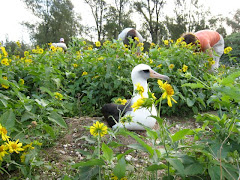










Kanu nei au, aia ʻiā ʻoe ka ulu.
“I plant and the growth is yours.”
[ʻolelo noʻeau]
Plant Module 6/18/10
By Norbert Larsen
One of the things that surprises me about Midway is the vegetation. Here there are vast stretches of ironwood trees, as well as plumeria, bougainvillea, coconut, shower trees, banyan, Norfolk pine, octopus trees, sea grape, banana, ti leaf plants and lots and lots of Verbesina (golden crownbeard) a noxious weed from the sunflower family. Prior to this visit, I had a completely different picture in my mind of what the atoll would look like. I imagined naupaka, pohuehue, native grasses and sedges, and other native ground-hugging vines and shrubs that perhaps I had never seen. I envisioned stretches of sand from one end of the atoll to other. I did not expect to see trees of any kind. I learned that tons and tons of soil were placed on the island since the early 1900s, and that thousands of people have lived here and brought with them their gardens and plants. I suppose if I had properly done my historical research prior to arriving, I would have been better prepared to meet the landscape that one finds today. The human footprint is everywhere here.
On this morning, we met Greg Schubert, Bio-Tech for Invasive Species with the U.S. Fish and Wildlife Service. He was a volunteer up here with the U.S.F.W.S. for four years before he was hired. He is going on his 8th year in his current position as Invasive Species Bio-Tech for the refuge, and his institutional knowledge is vast. He tells us that there are 259 species of plants on Midway, and that 19 of these are native. The rest are non-native, and the U.S.F.W.S. is combating 22 invasive species. One of the worst of the invasive weeds is Verbesina, and you can see it everywhere. The U.S.F.W.S. is working at restoring 300 acres on Midway—130 acres has been successfully restored. The success story is motivational. What seems like a daunting and almost impossible goal (native habitat restoration on Midway) is reachable in the optimistic and capable hands of the many people caring for Midway today.
After touring Midway’s native plant greenhouse, the PAA gang participated in our small way by planting native bunchgrass (Eragrostis sp.) on a sandy hillside once covered with Verbesina. On the same hillside, we could see an area planted by the PAA group last year, and the native bunchgrass is becoming firmly established. Greg tells us that the roadway next to the hillside becomes a vector for seeds because the wind blows down the roadway carrying seeds. Instead of carrying Verbesina seeds, the roadway now becomes a vector for carrying the seeds of the native bunchgrass. What an ingenious and efficient way to populate the nearby fields with native bunchgrass! Greg pointed out fields once covered with Verbesina, and now thriving with the native bunchgrass.
Verbesina was at one time removed with tractors, but this disturbs the soil, distributes seeds and actually encourages the growth of more Verbesina. Today, the U.S.F.W.W. uses a mild herbicide to kill off invasive weeds, or it removes the weeds manually in areas where the herbicide might threaten native plants. Our PAA gang worked near a couple of “duck seeps”—places where the ground has been dug out to reach the water table in order to make habitat for Laysan ducks. We manually removed Verbesina along with several other invasive weeds growing around the “duck seeps” where we could see Laysan ducks and ducklings waddling and paddling around. It was amazing to witness how quickly an area can be cleared when everyone works together!
The camaraderie in our new PAA family is growing, it is heartening, it is making me strong. Activities like this help to bring people together, and I am feeling the “shot in the arm” to make opportunities like this available to students at Waiʻalae Public Charter School where I work. It is clear that our islands are in need of more helping hands, of strong healthy communities, and it is clear that working to heal the environment can be a win-win for the ʻāina and for people.
Mahalo to PAA member Karen Matsumoto with the PAA group that visited Midway Atoll last year for gifting the gloves we used to do our work. The gloves stay here with the U.S.F.W.S. for others to use.
















